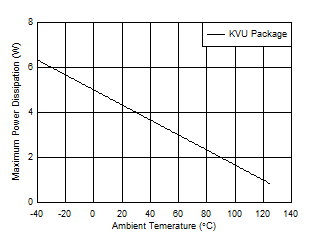JAJSSZ9I September 2008 – May 2024 TL720M05-Q1
PRODMIX
- 1
- 1 特長
- 2 アプリケーション
- 3 概要
- 4 Pin Configuration and Functions
- 5 Specifications
- 6 Parameter Measurement Information
- 7 Detailed Description
- 8 Application and Implementation
- 9 Device and Documentation Support
- 10Revision History
- 11Mechanical, Packaging, and Orderable Information
8.1.4.2 Power Dissipation Versus Ambient Temperature
Figure 8-4 is based off of a JESD51-7 4-layer, high-K board. Estimate the allowable power dissipation with the following equation. Improve thermal dissipation in the JEDEC high-K layout by adding top layer copper and increasing the number of thermal vias. See the An empirical analysis of the impact of board layout on LDO thermal performance application note. If a good thermal layout is used, the allowable thermal dissipation is improved by up to 50%.
Equation 4. 

 Figure 8-4 TL720M05-Q1 Allowable Power
Dissipation
Figure 8-4 TL720M05-Q1 Allowable Power
Dissipation